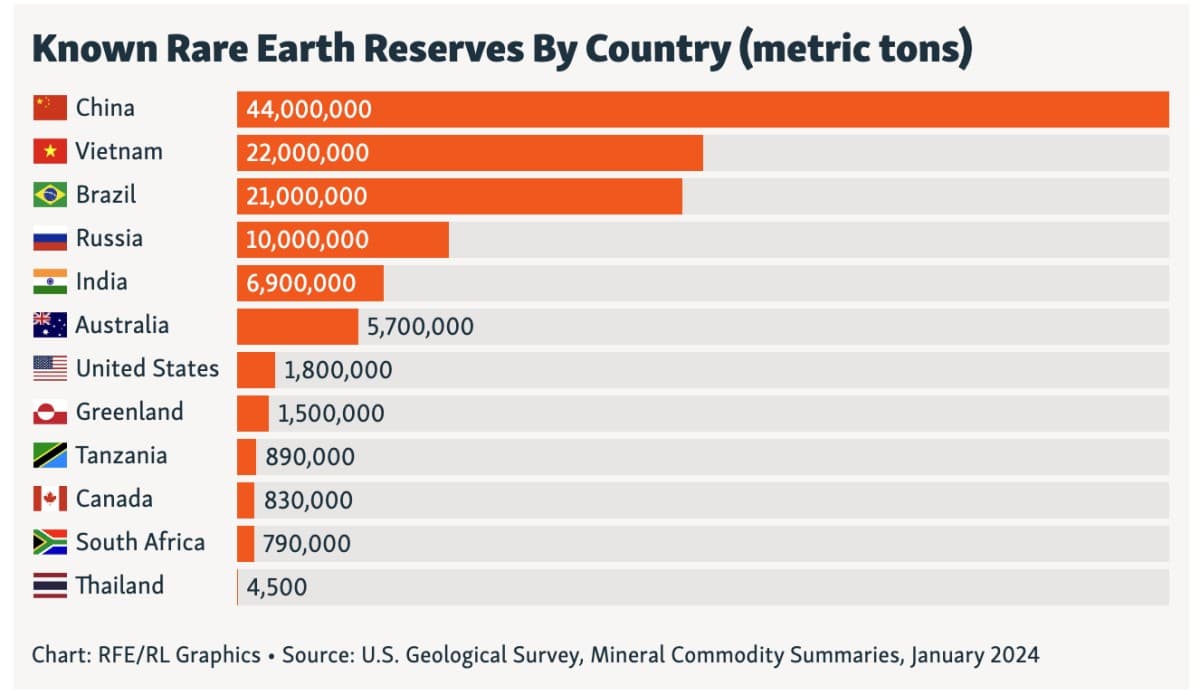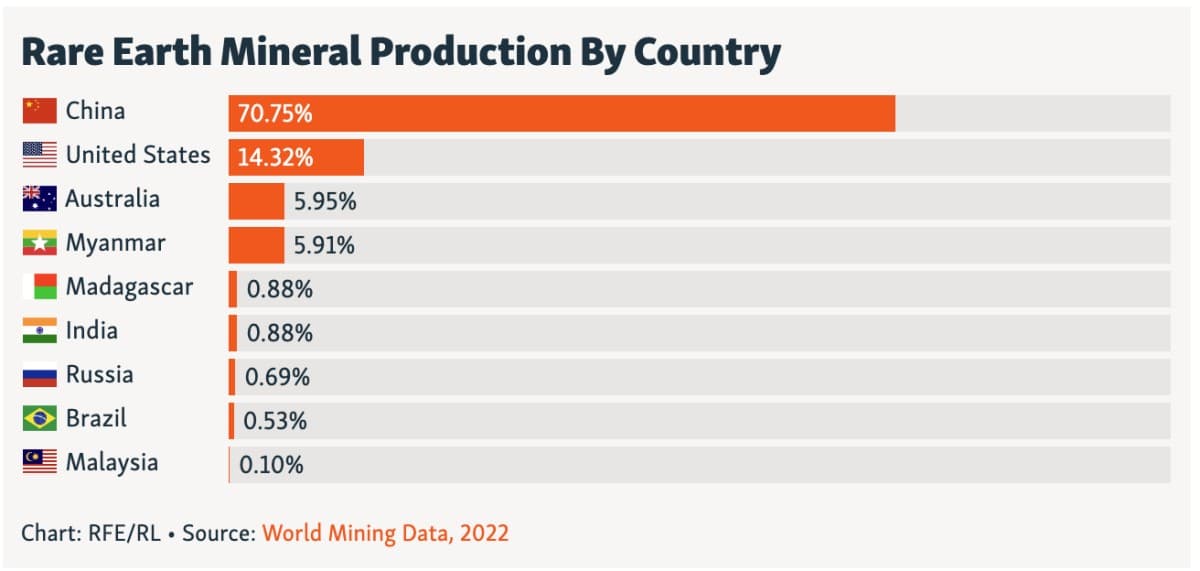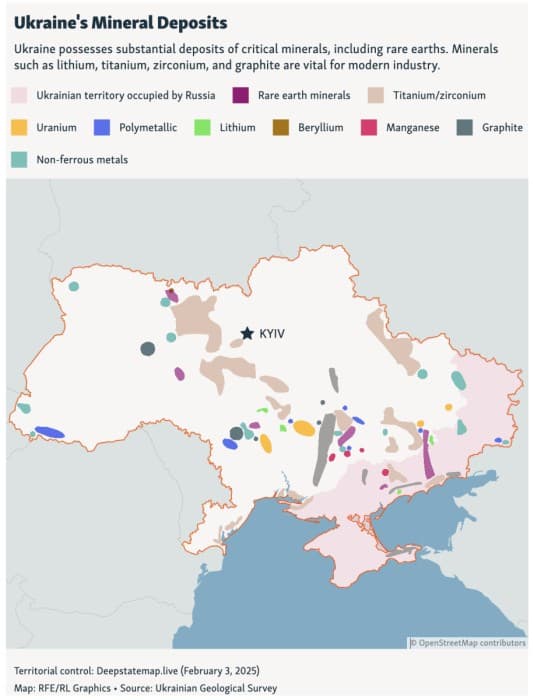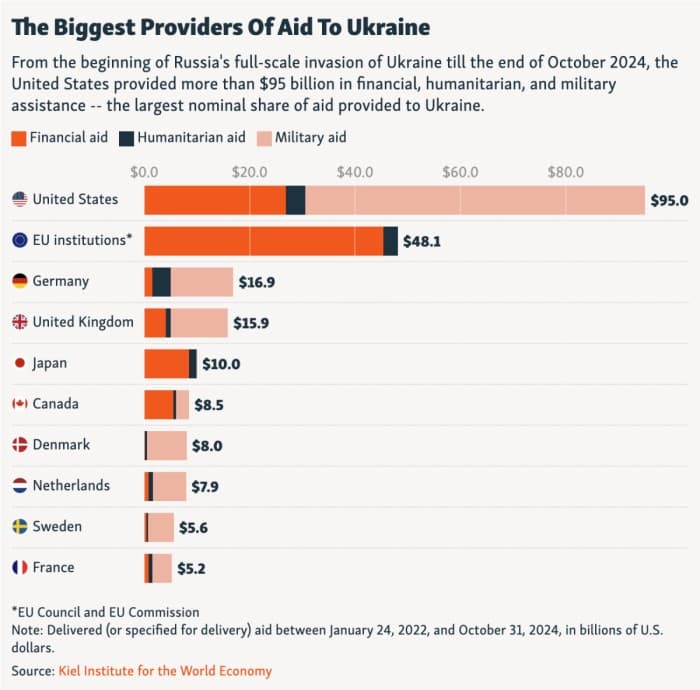It’s amusing to see a US influence operator, RFL/RL, trying to preserve an image of accuracy while carrying official water. Here, the case in point is Trump’s promotion of the idea that the US could continue to arm Ukraine if Ukraine mortgaged its future by paying the US via ownership or other concessions of its rare earths deposits, or as Trump put it, “rare earth” and one presumes other strategic materials.
Here we have Trump again proving himself to be the truest follower of the Kamala Harris exhortation, “What can be, unburdened by what has been.” Here the “what has been” includes what is. In this case, it’s that Ukraine has bupkis in the way of rare earths. Worse, the media has been simply parroting what Trump said as if Ukraine really had these goodies, as opposed to engaging in some throat clearing. So it sure looks like Trump is prepared to send Ukraine more arms in return for an empty bag.
Yours truly is not expert in these matters.Yet it was pretty obvious Trump and press transcriptionists were out over their skis on “rare earth”. One has to think the Chinese and Russians and many many others are sniggering at yet another display of imperial incompetence.
In fairness to RFE/RL, they did go to the trouble of making clear that Trump scheme and mainstream media amplification are barmycakes, and even found a source that could thinly dignify the Trump, erm, misapprehension. We are reposting the entire RFE/RL piece in full below, but here are the key bits. Please note we’ve posted charts and links in comments from Statista that come to essentially the same findings as the RFE/RL source:

Those who are not math challenged may have noticed that the Thailand deposits are a full four orders of magnitude smaller than those of China. As Dima of Military Summary is wont to say, “That’s a lot!” And of course, that Ukraine is nowhere on this list.
RFE/RL also kindly provided the production ranking:

It’s surprising to see the US rank as #2, particularly after all the handwringing about the US having abandoned rare earths mining and processing. For instance, from a 2019 article in Mining.com, How the US lost the plot on rare earths:
Unfortunately, the United States Military and dozens of high-tech North American companies are as dependent on China for their rare earth elements as the United Launch Alliance is on Russian-made rockets…
Without rare earths mined and processed in China, America would be unable to manufacture military hardware – rare earths are great multipliers they are used in making everything from computer monitors and permanent magnets to lasers, guidance control systems and jet engines. There is no substitute and no other supply source is available other than China. Civilian uses of rare earths would also be put in jeopardy. This includes rare earth elements incorporated into electric vehicle motors, computer chips, fiber-optic cables, flat-screen televisions, wind power turbines and nuclear power, just to name a few uses.
In 2010, we posted US Faces Substantial Obstacles to Increasing Rare Earths Production. It discussed both MIT Technology Review and New York Times articles on why the US had ceded rare earths production to China despite having adequate supplies:
In fact, the while the [MIT] article does discuss US versus foreign engineering expertise in rare earths mining, it describes in some detail how difficult rare earths mining is in general (more accurately, not the finding the materials part, but separating them out) and the considerable additional hurdles posed by doing it in a non-environmentally destructive manner. Thus the rub is not simply acquiring certain bits of technological know-how, but also breaking further ground in reducing environmental costs.
And this issue has frequently been mentioned in passing in accounts of why rare earth production moved to China in the first place. It’s nasty, and advanced economies weren’t keen to do the job. China was willing to take the environmental damage. For instance, the New York Times points out:
China feels entitled to call the shots because of a brutally simple environmental reckoning: It currently controls most of the globe’s rare earths supply not just because of geologic good fortune, although there is some of that, but because the country has been willing to do dirty, toxic and often radioactive work that the rest of the world has long shunned.
Forgive this digression, but it seemed useful to provide a mini-primer in case this Trump proposal has a longer half-life than it ought to. I am mystified at the US production figures being as high as RFE/RL shows in light of the upset about the US abandonment of the market as recently as 2019. Was there indeed a technology breakthrough? Did Biden provide an environmental waiver that went under the radar?
So back to RFE/RL, which provided an almost deadpan statement after the first of the two rare earths charts:
Ukraine has substantial amounts of rare earth minerals, according to the Ukrainian Geological Survey.
So the same Ukraine propaganda machine that brought us the Ghost of Kiev and most recently, the Trump-amplified claim that Russia has suffered a million deaths in the Ukraine war has apparently been treated as truthful when as far as I can tell, no reputable source on mineral reserves is buying what it is selling.
Many commentators have tried to burnish the Trump remarks by saying he likely meant lithium (which is not a rare earth) and other strategic minerals. Wellie, as various commentators have already pointed out, Ukraine has four major lithium deposits, two of which are under Russia’s control. The severity of gnashing of teeth when Russia recently captured the second of these two areas suggests that it represents the largest supply. Readers are encouraged to pipe up.
Ukraine has a lot of frackable gas, but over 80% is in Kharkiv or other eastern oblasts. Iron ore and coal are presumably mainly in the east since that’s where the Donbass heavy industry grew up. Ukraine’s black earth (its famed fantastic soil) is both east and west of the Dnieper, but looking at the distribution and type of crops farmed, my impression is that it’s disproportionately in the east (as in the land area east of the Dnieper is roughly a third of the country, but the black earth concentration in the east could plausibly be 50% of the total).
And any Ukraine mortgaging of these assets is subject to prior claims, such as nearly 30% of the farmland being owned by oligarchs and/or the likes of BlackRock and Vanguard. And if you think Westerners will come out ahead in a tangle with Ukraine’s oligarchs and the Banderite muscle they hire (as in specialists in the worst sort of torture), I have a bridge I’d like to sell you.
Another aside: it’s curious how Trump’s inexact patter repeatedly leads observers to interpret what he must have meant, as if trying to make sense of what a non-native speaker of the language is saying. This turns Trump communication into what Marshall McLuhan called a hot medium, like radio, where you hear words and then often add your own visual images. Hot media are active and engaging. Cold media like TV are passive because little is left to the imagination.
But to the big question of where Trump might be going with this “arms for minerals” talk. Here I have to differ with the Duran duo of Alexander Mercouris and Alex Christoforu. If I am representing them correctly, they see proposed bargain as Trump reducing his Ukraine dealings to a transaction. They contend that is being a big downgrade from the Collective West “we’re all in because democracy” patter. That may have been the US position but it was never Trump’s position.
Trump campaigned on the claims that the war would never had happened had he been re-elected in 2020 and he could do a deal to wind it up within 24 hours of assuming office. He never was on board with the “Zelensky as Churchill” and other conflict sales patter.
Trump’s willingness to entertain continuing to supply Ukraine with more materiel, even on supposedly paid basis, contradicts the former Trump promise to end the war quickly. And it’s a bastard cousin of the Ursula von der Leyen scheme to fund the war by floating bonds backed by the frozen Russian assets. It’s a a very shaky pretext for pretending to lend to Ukraine when the security interest, as they say in the business, can’t be perfected. In reality, any “loans” are subject to eventually being substantially or entirely written down.
But the fact that Trump floated this idea does not mean he is serious. It may simply be an effort to create another option, that the US still has a way to continue to supply weapons to Ukraine that Trump can make look palatable to the American public. The reason for doing that would be to try to bolster the weak US position in bargaining with Russia. That’s consistent with the NBC report of divisions in the Trump ranks on Ukraine: that some Trump insiders, like Mike Waltz and Keith Kellogg, want to double down on the failing Biden strategy of pumping more arms into Ukraine to achieve the Mission Impossible of improving their battlefield position before sitting down to talk.
By RFE/RL staff. Cross posted from OilPrice
- President Trump expressed interest in securing access to Ukraine’s rare earth minerals in exchange for continued US military aid.
- Ukraine responded positively to the proposal, indicating openness to collaboration with partners who can help protect their land.
- The demand for rare earth minerals, crucial for high-tech industries and defense, has intensified due to China’s dominance in production and recent export controls.
There’s already a flurry of diplomatic wrangling, backchannel talks, and public posturing ongoing between Washington, Moscow, and Kyiv, to figure out how to halt the nearly 3-year-old all-out Russian war on Ukraine.
Now add this to the mix: U.S. President Donald Trump wants to condition future U.S. aid to Ukraine on getting more access to the country’s valuable “rare earth” minerals — minerals that are in increasing demand for batteries, computers, smart phones, and electric cars, not to mention weaponry.
“We’re looking to do a deal with Ukraine where they’re going to secure what we’re giving them with their rare earth and other things,” he told reporters on February 3.
“I want to have security of rare earth. We’re putting in hundreds of billions of dollars. They have great rare earth. And I want security of the rare earth, and they’re willing to do it,” he said.
The reaction from Ukraine? We’re not opposed.
“We are open to the fact, that all of this can be developed together, along with our partners who can help us protect our lands,” Ukrainian President Volodymyr Zelenskyy said at a news conference in Kyiv. “This is absolutely fair. I talked about this in September when we met with President Trump.”

So What Is A Rare Earth Mineral, Anyway?
Rare earths are a class of about 17 minerals — for example, yttrium, cerium, lanthanum — that are found in trace amounts throughout the Earth’s surface. They’re in increasing demand because of their use in high-tech products. The ongoing race to make batteries smaller and lighter, and more powerful and longer-lasting, involves the use of rare earth minerals. Defense industries also need the minerals for weaponry and related technology.
Other rare earth minerals are used as chemical catalysts in magnets, computer drives, or generators.
The biggest hurdle for rare earth extraction is that you have to dig up a lot of soil to get an adequate amount of the minerals because they’re in such trace amounts. And then you have to separate out and refine them before you can employ them in technology or machinery.

Ukraine has substantial amounts of rare earth minerals, according to the Ukrainian Geological Survey.
It also has less-rare, more abundant minerals that are also coveted for use in technology and cutting-edge industries: lithium, for example, which is used widely in batteries of all sorts, and titanium, which is used in airplane manufacturing. Some estimates say the country’s lithium deposits could be valued at billions of dollars.
Trump may also have been referring to these minerals; he did not make that clear.
For the record, Ukraine also has far greater deposits of other, more common mineral resources — coal, iron ore, oil and gas – which provide major revenues for the country and also major investment opportunities.
Many of those resources are located in parts of Ukraine that are occupied by Russian forces — and may ultimately end up under total Russian control.
So Why Does Trump Want Them?
The race to locate, secure, develop, and monetize rare earth minerals has been accelerating for years now. Estimates of the minerals in North America stand at about 3.6 million tons in United States and more than 14 million tons in Canada, according to the U.S. Geological Survey, and the United States is the second-largest producer in the world after China. Australia and Burma are other major producers.
But in 2023, China, which produces about 60 percent of all rare earths in the world and processes nearly 90 percent, rattled global markets when it announced a ban on rare earth extraction and production.

That set off alarm bells in the West, where lawmakers and policymakers worried that Western technology would be crippled by a lack of supply of rare earth minerals.
China further jolted the discussion on February 3 — the same day Trump spoke to reporters — when it slapped tariffs on a range of U.S. goods in retaliation for tariffs announced over the weekend by Trump.
Beijing also imposed export controls on tungsten, tellurium, ruthenium, and molybdenum: critical minerals that are important in high-tech manufacturing but are not categorized as rare earths.
Can Trump Really Condition Aid To Ukraine On Access To Rare Earths?
Probably.
Ukraine is heavily dependent on the United States for the weaponry and equipment that has kept Kyiv in the fight against the Russian invasion. As of September, Congress had appropriated $174.2 billion for Ukraine-related purposes, with the majority of that going to Defense Department and defense-related accounts, according to the Congressional Research Service.
Trump, who has made ending the Ukraine conflict a top priority, and his advisers have signaled that part of the negotiations will include enticements and pressure to get Kyiv and Moscow to the negotiating table. Conditioning future U.S. aid on Ukrainian concessions is key to that; convincing Kyiv to give U.S. investors more access to rare earths and critical minerals could be a big part of the calculus.
Without U.S. weaponry, Ukraine’s military would buckle amid the grinding onslaughts from the bigger and better-equipped Russian troops. How long before its defenses would collapse outright is unclear.

It’s not the first time that Trump conditioned U.S. weaponry on concessions from Ukraine, specifically President Volodymyr Zelenskyy. During his first presidency, Trump was impeached by the Democrat-controlled House of Representatives after a phone call with Zelenskyy. In the call, Trump appeared to say he would unfreeze U.S. aid if Zelenskyy reopened an investigation into a Ukrainian energy company whose board included the son of Joe Biden, at the time a former vice president.
Lawyers argued a U.S. president has no legal right to withhold funding that has been appropriated by Congress.
Trump, who denied any wrongdoing and described the conversation as a “perfect phone call,” was acquitted by the Republican-controlled Senate.
This time around, Republicans control both chambers of Congress so it’s unlikely there will be strong congressional pushback on conditioning U.S. aid. Moreover, Trump and his advisers have embraced a more muscular approach to White House decision-making, arguing Congress has less involvement in executive branch decisions.
What Does The Kremlin Think About All This?
Russia also has substantial rare earth and critical mineral reserves, though its production capacity lags substantially behind China and other countries.
Broadly speaking, anything that complicates life for Ukraine is seen as a good thing for Moscow, which knows U.S. weaponry has kept Kyiv in the fight.
Russia, which has the upper hand on the battlefield, is doing its own positioning ahead of potential peace negotiations. That includes flattery from President Vladimir Putin.
One of the Trump White House bargaining chips has also been the threat to flood Ukraine with even more U.S. weaponry — which would be bad for Russian troops and the Kremlin.
Asked by reporters about Trump’s rare earth comments, Kremlin spokesman Dmitry Peskov said it appeared the White House was looking to make Ukraine pay for aid from Washington.
“This is clearly an offer to Ukraine to buy U.S. assistance,” he said.


Trump is potentially making another huge blunder here. The first was the awful “Trail of Tears” plan for the Gazans.
Any further aid to Ukraine after the last tranche of Biden’s expires (probably in a month or so) ties Trump to this debacle. It will be his baby, and the Dems can rightfully point the finger at him when the videos of helicopters leaving the US embassy with natives clinging to the landing gear come out in 2028.
True with a sorta of kaviat – knowing a lot of Trump supports from family, IMO the “what’s in it for us” mentally is noticeable among those I know. Meaning they could care less about ending the war in Ukraine because millions are dead and dying, but because Ukraine has gotten hundreds of billions, while they got nothing from it. But if they get something out of it or at least think they benefit (oil from Syria in return for American boots on the ground thats smart!) they tend to be generally OK with that. So Trump being able to say America will get Lithium as payment for continued support, they might see as shrewd vs the dumb Dems.
One possible explanation, and I only researched a little, is that the US is deficient in many of the 17 rare earths, except two
https://investingnews.com/daily/resource-investing/critical-metals-investing/rare-earth-investing/rare-earth-metal-production/
states all the US production is “neodymium and praseodymium” from one California mine.
The original source is:
https://www.usgs.gov/centers/national-minerals-information-center/rare-earths-statistics-and-information
which says, for example, that US scandium production has been zero since 1969.
Never mind the exotic stuff, recent Chinese moves about tungsten supply will limit the shell production of the west permanently. In the 70’s I met people picking up sugar bags of wolfram up Cape York and this should make it viable again if China persists.
I don’t think Trump really knows, or cares, much about Ukrainian lithium, rare earth, or other mineral reserves (except that they exist, and are worth XYZ bucks). I believe he just used the term as buzzword. He likes to sound smart, and this surely made him sound smarter than his “super-hypersonic” improvisation.
The four oblasts (and Crimea) annexed by Russia contain an estimated 50% of all mineral wealth in the Ukraine.
Another 20% to 25% is in the Dnipropetrovsk oblast. I don’t expect Russia to detour but they could get an easy 5% of the mineral wealth in the form of metal deposits by just taking a bite out of the east side of that oblast. Getting to the Dnieper/Dnipro river and/or besieging Dnipro would net them another 10%.
The only other oblast that Russia might end up controlling wold be Kharkiv but that is mainly gas reserves
Found this.
Ukraine has commercially viable deposits of 117 of the 120 commercially most used metals and 32 out of 34 classed as critical by the EU.
117 out of 120 metals. Biggest commercially viable rare earth deposits in Zaporizhzhia, Donetsk, and Cherkasy. Only Cherkasy is not territory that Russia gets to control (unless it takes over the entire Ukraine).
(original url and then to the archived version)
https://foreignpolicy.com/2022/04/28/ukraine-war-russia-resources-energy-oil-gas-commodities-agriculture/
https://archive.ph/mOZ1k
32 out of 34 critical:
https://foreignpolicy.com/2025/01/17/ukraine-economy-reconstruction-war-investment-united-states-europe/
https://archive.ph/Dqb2j
The United States ranked #2 for rare earth “mineral production” ma be based how production is defined. In this case it appears to be mined as ore, not processed to finished product.
The data source for the graph is found here on document page 168: World Mining Data 2022
The data are actually Rare Earth Ore-Content. Once ore is mined it may be ground and processed in a mill with chemicals to produce concentrate. It’s not uncommon for ore concentrate to be sold internationally for final processing.
More effort needed to confirm, but this appears to align with Yves’ statement about the US not wanting the environmental damage associated with rare earths (while being deceiving about what’s being produced).
I remember being in a department head (head of the whole depot on the Navy base) meeting where when the department head queried a senior lead engineer about getting a robotic painting project done on time, on cost (to which the engineer replied, sure!), he stated that he had higher odds getting his cat to to stack wood on his wood pile.
I think that cat will stack multiple wood piles and then randomly type out some Shakespeare before Ukraine makes any refined REE for Trump.
Researchers at WVU have developed a process to extract rare earth elements and critical minerals from acid mine drainage. Right now it is a very small scale operation but there is a lot of acid mine drainage throughout the nation that this process might be useful at remediating.
https://wvwri.wvu.edu/news/2023/09/13/wvu-s-water-research-institute-receives-additional-11mm-for-rare-earth-research
My already probably a year old prediction of how the conflict will end: triumphantly liberated West Ukraine, to be looted till nothing’s left by the West; and the triumphantly protected new Russian People’s Republics of the east, to be looted till nothing’s left by Putin & Friends.
In that context it doesn’t matter which and how much resources there really are for Zelenskyy to give up – the deal will be “all known, presumed, and possible” in perpetuity. The local oligarchy will be paid to keep the status quo (… reminds me of Afghanistan and that chopper that couldn’t take off because of all the cash weighing it down…) and whatever’s left of the local plebs will have the sovereign choice of either working for minimal wage for the new bosses, or not working at all (and starving to death).
In other words the difference between the Western and the Eastern parts will be only in the wallpaper and western media coverage (West good! East evil!).
As such, I’d welcome any and all arguments why and how things can turn up less bleak and medieval… I just don’t see any.